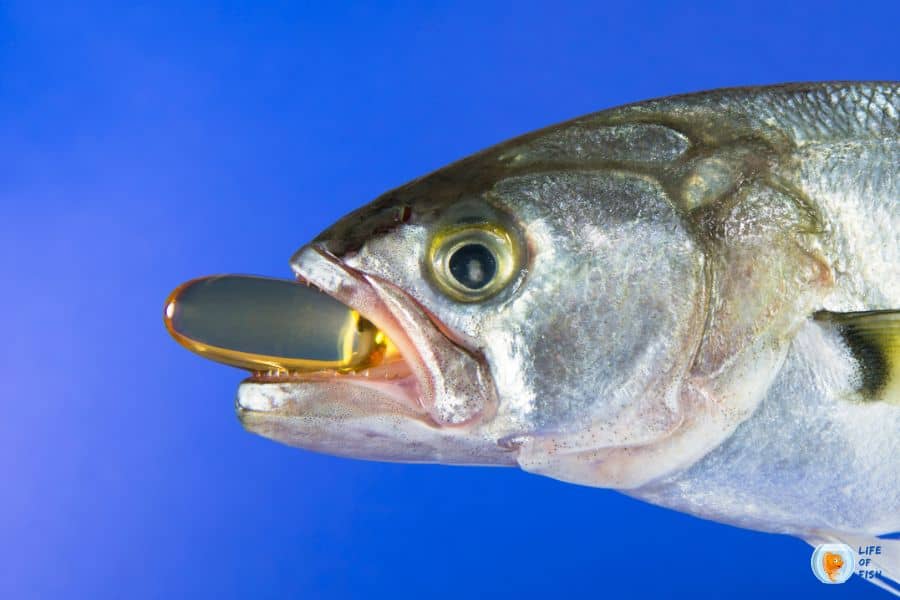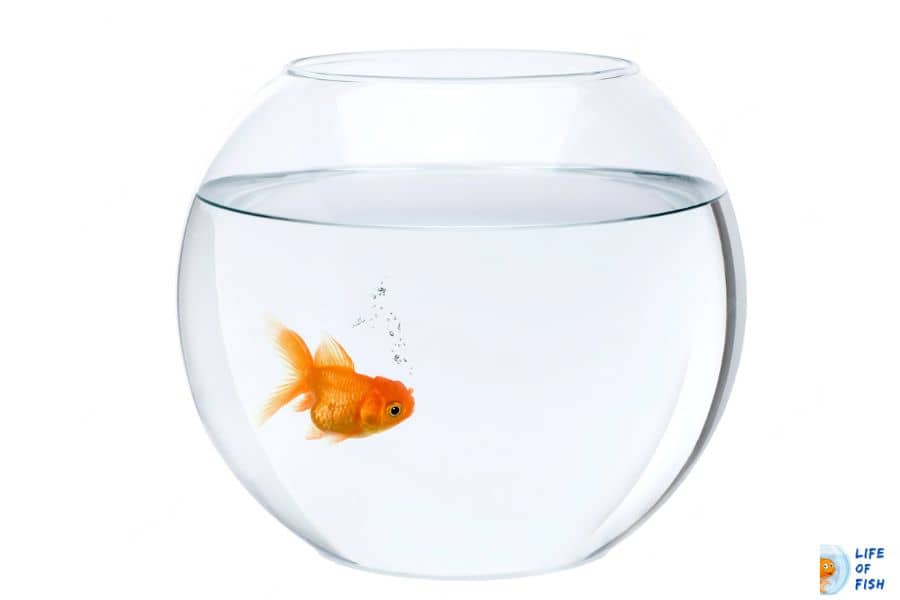Sick fish are difficult to manage, especially when it is hard to determine the root of the problem. The signs of a sick fish are often similar irrespective of the illness, making diagnosis difficult. Therefore, many hobbyists prefer to treat their fish with antibiotics in most cases. But what is fish antibiotics?

Fish antibiotics can be a helpful tool in treating and preventing illness in fish, but it is important to use them correctly. Different diseases work in different ways; some can be easily cured while others are more difficult to manage. In this article, we will discuss the use of fish antibiotics, their benefits, and some important considerations for their use.
What Are Fish Antibiotics?
Jump To
- 1 What Are Fish Antibiotics?
- 2 Bacteria Types
- 3 Antibiotic Types
- 4 Treating Fish With Antibiotics
- 5 Signs And Symptoms Of Bacteria Infections
- 6 Causes Of Bacterial Infections
- 7 Benefits of Fish Antibiotics
- 8 Dangers Of Fish Antibiotics
- 9 How To Administer Antibiotics To Your Fish?
- 10 Best Fish Antibiotics
- 11 Conclusion
- 12 Related question
Aquarists use fish antibiotics to treat bacterial infections in fish. They are similar to the antibiotics that are used to treat bacterial infections in humans, but they are specifically designed for fish. Online retailers that sell fish supplies sell fish antibiotics. They are available in various formulations, including tablets, capsules, powders, and liquids.
The most common type of fish antibiotic is an oral tablet. It is first dissolved in water and then add to the fish tank. This type of antibiotic is typically used to treat a wide variety of infections, including bacterial infections, fungal infections, and parasites.
There are also injectable antibiotics that are available for fish. These are typically used to treat more serious infections, such as systemic or those resistant to oral antibiotics. Injectable antibiotics are not as common as oral antibiotics. They are only used by experienced fish keepers.
Fish antibiotics are generally safe to use, but it is important to follow the instructions on the package carefully. Overdosing fish with antibiotics can lead to serious health problems, including organ damage and death. Further, using the wrong antibiotic to treat a fish can also be dangerous. As you may not know, you need to be aware of two main types of bacteria, which we will discuss below. These bacteria work differently and therefore require different types of antibiotics.
Bacteria Types
There are two main types of bacteria: gram-positive and gram-negative.
- Gram-positive bacteria have a cell wall made up of a single layer of peptidoglycan. This type of bacteria is typically less dangerous and easier to treat than gram-negative bacteria.
- Gram-negative bacteria have a cell wall made up of two layers of peptidoglycan. This type of bacteria is typically more dangerous and difficult to treat than gram-positive bacteria.
The gram stain is the most definitive method to identify gram-positive bacteria from gram-negative bacteria, hence the name. Gram-positive bacteria will turn blue, while gram-negative bacteria will become pink after being stained with a Gram staining solution. Usually, antibiotics used to treat gram-positive bacteria will not be as effective against gram-negative bacteria and vice versa. As a result, before administering antibiotics to your fish, it is vital that you correctly identify the type of bacterium.
Gram-negative infections, such as columnaris or fin rot, are the most prevalent type of bacterial infection in fish. Oral antibiotics (if caught early) are the best solution for these infections. For your reference, here is a list of some common bacterial infections found in fish.
Gram Positive Bacterial Infections in Fish
- Streptococcus spp.
Gram Negative Bacterial Infections in Fish
- Aeromonas spp. (Dropsy)
- Flavobacterium spp. (Columnaris)
- Vibrio spp.
- Pseudomonas spp. (Fin rot)
Antibiotic Types
Generally, antibiotics used to treat fish are the same as the ones used to treat humans but in a lower dosage. They are available in several brand names but the most common ones used are:
- Ampicillin
- Cephalexin
- Erythromycin
- Clindamycin
- Doxycycline
- Metronidazole
- Sulfadimethoxine
- Trimethoprim
- Tetracycline
Most of these antibiotics are available in pet stores without a prescription. Some are also labeled as “broad-spectrum” antibiotics, which means they can be effective against a wide range of infections.
Caution: Although some fish antibiotics are labeled as human grade, some people tend to use them for themselves. This is strongly discouraged since it can lead to antibiotic resistance, which is exceedingly dangerous.

Treating Fish With Antibiotics
When choosing an antibiotic, it is vital to select one that is effective against the specific type of bacteria causing the infection. As we mentioned earlier, gram-positive and gram-negative bacteria require different types of antibiotics. For example, if your fish has a gram-positive infection, such as strep, you would use an antibiotic that is effective against gram-positive bacteria, such as erythromycin or amoxicillin.
On the other hand, if your fish has a gram-negative infection, such as columnaris, you would use an antibiotic that is effective against gram-negative bacteria, such as metronidazole. Additionally, some antibiotics such as Tetracycline aren’t effective in saltwater aquariums, and some antibiotics such as penicillin and ampicillin aren’t effective in fish.
Choosing the wrong type of antibiotic will not only be ineffective but can also make the infection worse. Therefore, knowing the symptoms of each disease and proper diagnosis by a vet is essential before starting any treatment. However, your vet may also misdiagnose sometimes even though he has years of experience.
If you are unsure about the diagnosis, seek a second opinion from another veterinarian or a knowledgeable fish keeper. Once you have chosen the right antibiotic, the next step is to select the delivery method.
Signs And Symptoms Of Bacteria Infections
While many different forms of bacteria can infect fish, just a few are common among aquarium fish. Let’s talk about the signs and symptoms of each one.
Streptococcus spp.
Streptococcus is a deadly gram-positive bacteria that can infect fish via open wounds. It multiplies quickly and causes severe tissue damage, resulting in death within 48 hours if left untreated.
Signs and symptoms:
- lethargy
- loss of appetite
- abnormal behavior (spinning)
- red streaks on the body
- bloody spots on the fins
- pop eyes
- bloating
If you observe any of the above signs, it is important to start treatment immediately as the infection can spread quickly and be fatal.
Aeromonas spp. (Dropsy)
Aeromonas is a gram-negative bacteria found in pond fish. It can also infect aquarium fish via open wounds or contaminated food.
Signs and symptoms:
- bloating
- swelling
- dropsy
- ulcers
- loss of appetite
- lethargy
- fin rot/tail rot
- hemo/melanophores (black spots on the body)
If you see any of the above signs, it is important to start treatment immediately as the infection can spread quickly and be fatal.
Flavobacterium spp. (Columnaris)
Flavobacterium is a gram-negative bacteria found in ponds and aquariums. It can infect fish via open wounds or contaminated food.
Signs and symptoms:
- ulcers
- fuzzy growth on the skin
- moldy or cottony ulcers in the mouth
- fin rot/tail rot
- loss of appetite
- lethargy
If you see any of these signs, it is important to start treatment immediately as the infection can spread quickly and be fatal.
Vibrio spp. (Vibriosis)
Vibrio is a gram-negative bacteria that is commonly found in ponds and aquariums. It can infect fish via open wounds or contaminated food.
Signs and symptoms:
- ulcers
- fin rot/tail rot
- hemorrhage
- loss of appetite
- lethargy
If you observe any of these signs, it is important to start treatment immediately as the infection can spread quickly and be fatal.
Pseudomonas spp.
Pseudomonas is a gram-negative bacteria that is commonly found in aquariums. It can infect fish via open wounds or contaminated food.
Signs and symptoms:
- ulcers
- fin rot/tail rot
- hemorrhage
- loss of appetite
- lethargy
If you observe any of the above signs, it is important to start treatment immediately as the infection can spread quickly and be fatal.

Causes Of Bacterial Infections
There are many different ways that bacteria can infect fish. Some of the most common include:
- Open wounds: Fish can get open wounds from fighting, injuries, or surgery. These wounds provide an entry point for bacteria to enter the body and cause an infection.
- Infected food: If fish eat infected food, they can develop a bacterial infection. This is why it’s important to quarantine new fish and feed them frozen or freeze-dried food until you are sure they are healthy.
- Contaminated water: If the water in an aquarium or pond contains bacteria, fish can develop infections. This is why it’s important to do regular water changes and keep the tank clean.
Benefits of Fish Antibiotics
Fish antibiotics use to treat a wide variety of bacterial infections in fish. They are typically safe and effective when used as directed. Some of the benefits of using fish antibiotics include:
- They are typically safe and effective when used as directed.
- They are a cost-effective way to treat bacterial infections.
- They are easy to administer and you can add them to the water in an aquarium or pond.
- Antibiotics are available in a variety of formulations, including oral tablets, capsules, and liquids.
- Some fish antibiotics are broad-spectrum and you can use them to treat a variety of infections.
Dangers Of Fish Antibiotics
When taking fish antibiotics, there are a few risks to be aware of. First, it’s important to only use them as directed. Overusing or misusing antibiotics can lead to the development of antibiotic-resistant bacteria. This indicates that antibiotics will no longer be effective against the bacteria, and the infection will be more difficult to treat.
Second, some fish antibiotics contain ingredients that can be toxic to humans therefore you have to use them carefully. So, it’s important to read the label carefully and follow the directions. Finally, fish antibiotics can interact with other medications, so it’s important to talk to your veterinarian before using them.
How To Administer Antibiotics To Your Fish?
There are several ways that you can administer antibiotics to your fish. The most common include:
Adding them to the water
This is the most common method of administering antibiotics to fish. You will need to add the appropriate amount of antibiotics to the water according to the package directions. However fish will absorb the medication through osmoregulation, and it will enter their bloodstream.
Injecting them
Some antibiotics inject directly intramuscularly or subcutaneously. This is a veterinarian job and it is expensive. Therefore, most fish owners opt to add the medication to the water. However, this method is the most effective as it gets the medication directly into the bloodstream.
Feeding them
for instance, some antibiotics can be added to fish food. This allows the fish to eat and absorb the medication through the digestive tract. However, feeding antibiotics may not be a practical option if your fish reject the medicated food.
Best Fish Antibiotics
As previously said, there are several types of antibiotics available on the market under various brand names. However, some are more effective on fish than others. These are the best fish antibiotics(or a mix of antibiotics) that you can use:
API Furan-2
API Furan-2 is a broad-spectrum antibiotic that is effective against a wide variety of bacteria. It can specifically treat for,
- Open red sores (Aeromonas spp.)
- Columnaris (Flavobacterium columnaris)
- Bacterial gill disease
- Body slime
- Cloudy eye
- Fin rot
However, you can use this medication in combination with other fish antibiotics such as Seachem Kanaplex and/ or metroplex.
Thomas Labs Cephalexin (Keflex)
Keflex is a cephalosporin antibiotic that treats a wide range of bacterial illnesses. It is one of the most commonly used antibiotics in fish. Thomas Labs Cephalexin is a broad-spectrum antibiotic that is effective against gram-positive and gram-negative bacteria. Furthermore, If you are unsure of the sort of bacteria causing the infection, this is a good option. It is available to buy in both capsule and powder form. You can add these capsules to the water or feed the fish. The powder can be mixed with food.
Nitrofuracin Green Powder
Nitrofurantoin is a nitrofuran antibiotic that is effective against a wide variety of bacteria. This product contains methylene blue, as well as nitrofurazone and sulfathiazole sodium. Nitrofuracin Green Powder can be used to treat wounds and infections. However, it kills nitrifying bacteria. So, it should not be used in ponds or aquariums with live plants. Given that this product can be used as an alternative to API Furan-2.
API Triple Sulfa
Among all other antibiotics, this one is the safest and most gentle. API Triple Sulfa is a safe and effective way to treat bacterial infections in fish. It uses a combination of three medications: sulfamethoxazole, trimethoprim, and sulfathiazole. What’s special about this antibiotic is that it doesn’t kill all of the nitrifying bacteria, which means it can be used in ponds and aquariums with live plants. However, this product will be effective only on gram-negative bacteria.
Enrofloxacin
Enrofloxacin is a veterinary medicine used to treat bacterial infections in dogs, small mammals, birds, and reptiles. Recent studies have shown the high efficiency and safety of enrofloxacin when used to treat bacterial infections in fish. This antibiotic is available in both oral and injectable forms.
This antibiotic can be used as a broad-spectrum antibiotic, and it’s a fast-acting fluoroquinolone. Fluoroquinolones are a type of antibiotic that kill bacteria by inhibiting the enzymes that they need to reproduce. This means that the bacteria are not able to reproduce and eventually die.
AAP Spectrogram
The AAP Spectrogram offers the industry’s broadest range of gram-positive and gram-negative drug treatments. It is recommended for all chronic or undiagnosed diseases (other than parasitic infestations). AAP Spectrogram is an excellent choice when confronted with sick fish and works to treat both gram-positive and gram-negative infections.
This broad-spectrum antibiotic not only helps to resolve the current infection but also prevents future outbreaks. However, AAP Spectrogram is incredibly hard to find and is very expensive.

Conclusion
There are a variety of fish antibiotics that you can use to treat your fish. The best fish antibiotic will depend on the type of infection that you are treating. However, if you are unsure about the type of bacteria causing the infection, it is best to use a broad-spectrum antibiotic such as Thomas Labs Cephalexin.
However, if you are treating a specific type of infection, you may want to use a more targeted antibiotic such as API Triple Sulfa. Whatever antibiotic you choose, make sure to follow the directions on the package carefully.
Related question
What Are Natural Antibiotics?
Natural antibiotics are substances that can kill or inhibit the growth of bacteria. Examples of natural antibiotics include garlic, honey, and ginger. Some people believe that natural antibiotics are safer and more effective than conventional antibiotics, but this claim is not supported by scientific evidence.
Are Natural Antibiotics Safe For Fish?
There is no scientific evidence to back up the assertion that natural antibiotics are safe to fish. In fact, some natural antibiotics, such as garlic, can be toxic to fish. If you are considering using a natural antibiotic to treat your fish, it is best to speak with a veterinarian first.
Is It Ok For Fish To Take Human Antibiotics?
No, it is not safe for fish to take human antibiotics. Human antibiotics are not designed for use in fish and can cause serious side effects. If you suspect your fish has a bacterial infection, consult with a veterinarian. They can prescribe the appropriate antibiotic for your fish.
Is It Ok For Humans To Take Fish Antibiotics?
Yes, generally, it is safe for humans to take fish antibiotics. Antibiotics for fish are the same as antibiotics for humans. However, they are often much cheaper. However, you should only take fish antibiotics if you have been prescribed them by a doctor. Self-medicating with antibiotics can lead to serious health complications such as treatment failure and antibiotic resistance.
Read Next : Fish Tank Computer | A Crazy Invention |
